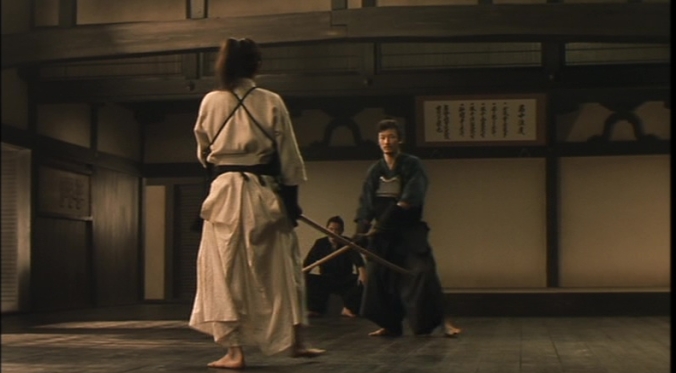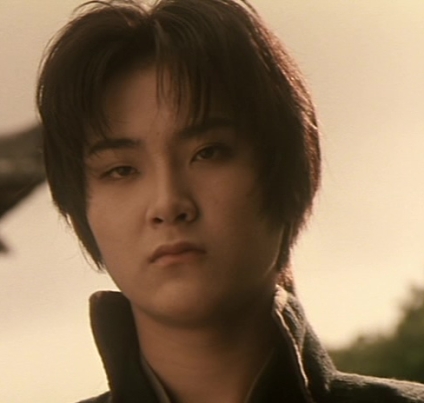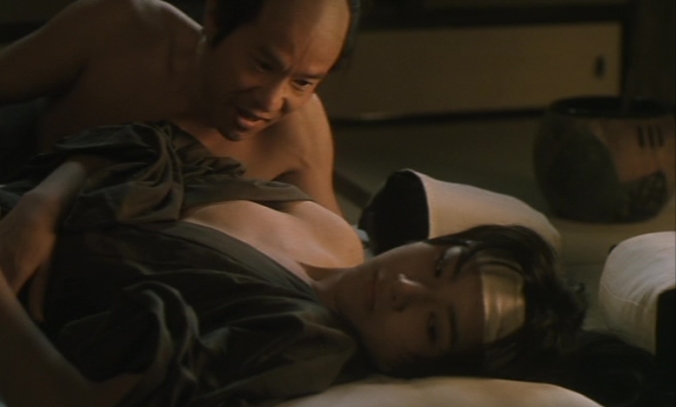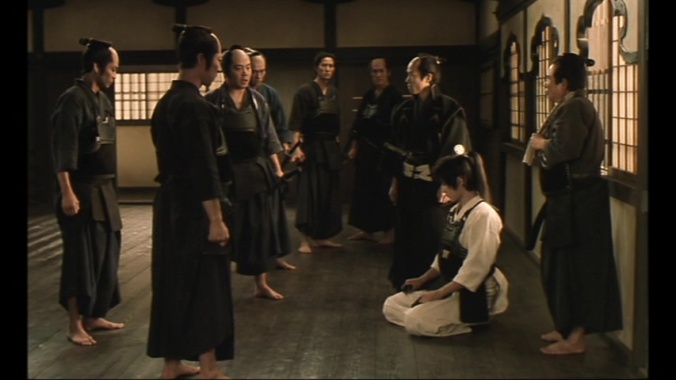 The Shinsengumi had disappeared from Japanese films for the most part around 1970, so it is something of a surprise to see them reappear as a major subject in Gohatto. Even more surprising is that it is a movie by Oshima, who had never shown any previous interest in jidai-geki or in films with sword-play and had often ridiculed them in interviews.
The Shinsengumi had disappeared from Japanese films for the most part around 1970, so it is something of a surprise to see them reappear as a major subject in Gohatto. Even more surprising is that it is a movie by Oshima, who had never shown any previous interest in jidai-geki or in films with sword-play and had often ridiculed them in interviews.
Adapted by him from stories written by Ryotaro Shiba in the sixties, Gohatto begins as the Shinsengumi are expanding their ranks after the Ikedaya raid. Initially made up of only ronin, they began to take in members of other classes as the threat from the rebellious Satsuma and Chosu clans grew. Our first scene shows candidates being tested in sword skills, and only two men survive the test. One is the ronin Tashiro, the other Kano, a third son of a rich merchant.
Played by the 15-year-old Ryuhei Matsuda, Kano is so beautiful that the audience might mistake him at times for a girl, but he is definitely a boy and a swordsman far more skilled than most of the current Shinsengumi. He may or may not be homosexual himself – he initially rejects male advances but when taken to the pleasure district he refuses to have sex with the beautiful geisha hired for him – but he most certainly becomes the immediate object of desire for several members of the group, beginning with Tashiro whom he apparently rejects.
All of this is observed by Hijikata (Takeshi Kitano), the group’s “enforcer” who set up the extremely strict rules of the organization, all of which are punishable by death. When the commander Kondo selects Kano as his page, Hijikata wonders if Kondo is “so inclined.” This in itself is no problem. Hijikata knows that several of the group are also “so inclined” and among the many prohibitions in the organization, homosexual activity is not one. Kano, however, seems much more disruptive, like a woman dropped into an all-male setting, almost purposely tempting advances by not cutting his girlish hair into the samurai shaved forehead and wearing white whenever not actually in group battles. Eventually Susumu, one of the ten unit leaders, crawls under his covers. This is the only actual sex act shown in the movie and the critical action is hidden by the covers, but Kano is strangely inexpressive throughout the entire scene, enduring rather than either resisting or enjoying. When Susumu is later found dead, it is assumed one of the enemy groups attacked him when he was out alone.
This is the only actual sex act shown in the movie and the critical action is hidden by the covers, but Kano is strangely inexpressive throughout the entire scene, enduring rather than either resisting or enjoying. When Susumu is later found dead, it is assumed one of the enemy groups attacked him when he was out alone.
Later, Kano befriends the oldest unit leader Inoue and goes so easy on him in a practice session that observers from another clan use it to ridicule the Shinsengumi as a whole. Eventually a battle between the clans occurs, in which the Shinsengumi lose several men. Inoue is himself attacked in the night, and a clue points to Tashiro, assumed to have attacked Inoue out of jealousy for his relationship with the young man. Kano is ordered to kill Tashiro, but before he does, we learn that the actual attacker was Kano. As Kano walks off into the mists, unit leader Soji follows him, leaving Hijikata so frustrated that he slices through a cherry tree.
To discuss the ending is not a spoiler because the movie is not set up like a mystery. The true mystery is Kano himself. He seems to have no feelings, no emotional responses himself. When asked why he hasn’t cut his hair, he says only “I have my reasons.” His only explanation for joining the Shinsengumi is that he wants to kill, and on his first day he coolly beheads a member of the company without any sense of hesitation, much less any expression. In this desire for killing, he is similar to Enami in Bakumatsu zankoku monogatari or Ikada in Hitokiri, or even Ryunosuke in the Daibosatsu toge story, yet he is completely different – calm, quiet, self-contained as well as very young. It is as if he is some kind of avenging angel sent to bring discord among the group, like the Scarlet Camellia or Ayako Wakao in Irezumi, but if so, we never know his motive.
Historically, the film plays fast and and loose with the facts – Susumu, Inoue, and Soji all survived until at least 1868 and died in battle or of TB. Similarly, Oshima and his costume designer Emi Wada dispense with the distinctive and famous Shinsengumi white or blue uniforms, dressing entirely in black with only the inverted chevrons retained so subtly that they are often invisible.
Though the movie deals with jealousies and destruction from homosexuality, it never suggests that homosexuality itself is destructive. The problem as seen by Hijikata is Kano’s ability to disrupt the way homosexuality is usually practiced within the group. He inspires the kind of sexual desire and intensity seen in Oshima’s Empire of Passion, but without apparently making any effort to do so. He is emotionless while those around him are stirred to emotions they can not control or never knew they had. Unlike Billy Budd, who stirs similar confusions among his officers, he is aware of what is happening, and once the killings start we learn that at least some of what he does is intentional. Nevertheless, he remains an enigma.
For students of Oshima, it can be seen as part of a series about sexual desire beginning with In the Realm of the Senses, but the particular movie it most suggests is Merry Christmas, Mr. Lawrence. Not only does it re-unite Oshima with Kitano and Ryuichi Sakamoto, who provided the haunting score, but Matsuda has that strange ambi-sexual aura which David Bowie had provided to that earlier movie. This may be purely a matter of his age and inexperience that limited his expressive skill, but nevertheless it is there.
After a lifetime of rebellion against Japanese society and the way Japanese movies were made when he was younger, Oshima ends his career with a visually traditional movie. It is inarguably Oshima’s most beautiful film, but he never strove for beauty before. Everything is clearly shot in the studio,* with Mizoguchi’s slow dollies, Kinugasa’s tight color palettes, and even Kurosawa’s wipes. It follows the typical structure of the chanbara, with fights at the beginning (this time in the school) to demonstrate the principal’s skill, a series of small brawls, practice sessions, and skirmishes to keep action going while personal story lines are dealt with, leading to a final duel between the two opponents who began as possible friends. Ironically, it appears to also have been Oshima’s most commercially successful movie in Japan itself (In the Realm of the Senses made its money overseas, since it was actually banned in Japan).
* This may have been because Oshima directed much of the movie from a wheelchair.
“The Lad With Bangs,” an episode of the television mini-series from the Ryotaro Shiba novel “Shinsengumi Keppuroku” covers the same subject as Gohatto. The main difference is that Kano is not shown as feminine at all, but rather as a young boy, which would appeal to another type of “inclination.” The story is still the same otherwise, and with impeccable sword skill he cuts down his victims.
LikeLike
At only 15, Kano would certainly qualify as a “boy” today; that was the age of the actor, but I don’t think anyone actually mentioned an age during the course of the film, now that you mention it.
LikeLike
I think that the 21st century way to describe the difference in how each version portrayed the character is that in the film version Kano looks non-binary, while in the TV version he looks boyish.
LikeLike
Pingback: When the Last Sword is Drawn / Mibu gishi den (2003) | Japanonfilm
Pingback: Blue Spring / Aoi haru (2001) | Japanonfilm
Pingback: Umbrella Flower / Kaza-hana (2000) | Japanonfilm
Pingback: Zatoichi (2003) | Japanonfilm
Pingback: Nana (2005) | Japanonfilm
Pingback: Women in the Mirror / Kagami no onna-tachi (2002) | Japanonfilm
Pingback: Gojoe / Gojo reisenki: Gojoe (2000) | Japanonfilm